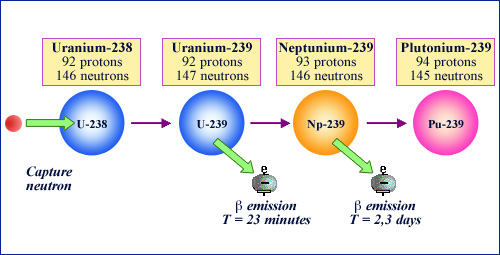Transforming a fertile nucleus into a fissile nucleus
Uranium-238 accounts for more than 95% of the uranium present in the core of reactors. It participates marginally to the chain reaction, but it nevertheless plays an important auxiliary role. By capturing a neutron, it becomes a nucleus of plutonium-239. Later on this plutonium-239 nucleus may undergo a fission if it again captures another neutron. Somehow, uranium-238 can be viewed as splitting with a delay or by proxy. It generates nuclear fuel by providing fissile nuclei: it is said fertile.
The mechanism of generation of plutonium involves several stages. By capturing a neutron, uranium-238 becomes uranium-239 that rapidly changes by beta decay into neptunium-239. This neptunium is transformed then again by beta radiation, after 3 days on average, into a new nucleus: plutonium-239. This radionuclide is fissile, like uranium-235.

Plutonium-239 generation
The capture of a neutron by a nucleus of uranium-238 leads to the formation within a few days of a nucleus of fissile plutonium-239. The nucleus of uranium-239 resulting from the capture of the neutron is radioactive beta-minus. By emitting an electron and an antineutrino, it becomes neptunium-239, which being itself unstable transforms through a second beta-decay into plutonium-239.
© IN2P3
Plutonium-239 is a good nuclear fuel: split by fast neutrons, it releases an average of 2.30 secondary neutrons per neutron captured. Of these secondary neutrons, one is required to maintain the chain reaction. Then 1.30 remains available.
If on average, one of these available neutrons is captured by a nucleus of uranium-238 transforming it into plutonium-239, the reactor produces as much fuel as it consumes. When more than one neutron produces plutonium (with an adequate configuration of the reactor core), the reactor is called breeder. Otherwise, the reactor is called a “sub-generator.” The handful of reactors that have operated as breeders are fast neutron reactors.
The conditions for regeneration are very far from being met for conventional reactors of nuclear power plants that use slow neutrons. However, significant quantities of plutonium are generated in their irradiated fuel.
The amount of plutonium produced from the origin of the worldwide fleet of reactors was estimated in the year 2000 at 1400 tons, of which 60% is plutonium-239. This amount was growing by 70 tons per year.
Learn more :
Plutonium-239
Slow and fast neutrons
Breeding
Other articles on the subject « Nuclear Fission »
200 millions electronvolts !
A huge amount of energy at the atomic scale The fission of a uranium or plutonium nucleus liberat[...]
Chain Reaction
From one single fission to fissions on a massive scale Nuclear fission emits a lot of energy on t[...]
Fissile nuclei
Uranium 235 and 233, plutonium 239 The few fissile nuclei found in nature belong to heavy atoms, [...]
Fission fragment
Chronicle of the life of a fission fragment … The fission of a nucleus into two fragments i[...]
Fission products
The ashes of nuclear fission Fission products are the remains of a heavy uranium or plutonium nuc[...]
Short-lived Fission Products
Most fission products vanish rather rapidly The vast majority of the radioactive fission products[...]
Long-lived Fission Products
A handful of tough but little radioactive isotopes … The more a nucleus is long-lived, the [...]
Actinides
A class of very heavy radioactive nuclei Alongside the fission products found in the core of nucl[...]
Plutonium Isotopes
Plutonium-239 but also 238, 240, 241, 242 … Plutonium isotopes are produced by neutron capt[...]
Minor Actinides
Neptunium, americium and curium Minor actinides constitute a very small minority of high activity[...]